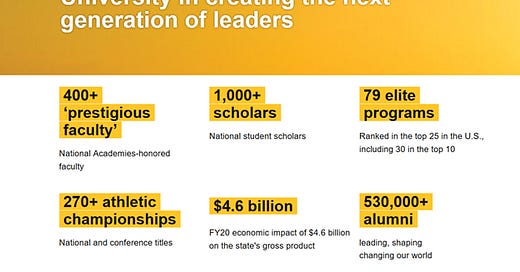Does the Future of Higher Education Look Like Arizona State University?
Characteristics of the “New American University”

Institutions of higher education have been evolving since Harvard College was founded in 1636. From small colonial colleges to elite private schools and large public research institutions, higher education is continually growing and becoming more complex to meet the variety of needs in our society.
But what does the future look like? Maybe it looks like Arizona State University (ASU): the self-proclaimed “New American University.” In The Fifth Wave: The Evolution of American Higher Education, ASU President Michael Crow and historian William Dabars document the rise of ASU within the context of four previous “waves” of higher education evolution. They argue that ASU is the “fifth wave” of institution types and serves as the prototype for the future.
Think of this fifth wave as a mash up of all the best features of other institution types: the academic excellence of the Ivy League, the innovation of UCLA, and the online scale of Western Governors University. But what does this look like in action?
Here are three key characteristics that, when combined, define ASU as the prototype of the next generation of American universities (information below sourced from The Fifth Wave).
1. World Class Research and Innovation
Although ASU is one of the youngest research-extensive universities in the country, it has hundreds of millions of dollars a year in research expenditures and is the fastest-growing research enterprise in the United States. ASU also holds the title of most innovative university (ahead of MIT even!) from the US News University Rankings.
ASU does research differently than other major research universities in two ways. First, ASU focuses on transdisciplinary problem-solving as opposed to dated departments organized by field of study and focused on individual faculty research programs. ASU, rather, develops research centers, institutes, and schools that are focused on solving societal problems by combining faculty of all fields and expertise to drive innovation and collaboration at an accelerated pace.
Second, ASU takes what they call an “entrepreneurial” approach, forming extensive partnerships outside the university with different companies and businesses, such as a recently announced innovation center with Starbucks. These partnerships more closely connect the university with the needs of society to ensure student preparedness and drive innovation into needed areas.
2. Scale and Accessibility
ASU believes that a research grade education should be accessible to any qualified student. Where ASU differentiates itself from other leading research institutions like University of Michigan or UCLA is that it admits far more students and a far more heterogenous set of students. Research institutions are increasingly known for the exclusivity – how many students they reject. ASU, rather, aims to be known for inclusivity – how many students they accept.
American research institutions educate approximately the top 10% of college-eligible students, with those numbers becoming more and more constrained as admissions competition becomes increasingly intense. ASU aims to educate the top 25-35% of students, greatly increasing the availability of a research-grade education.
ASU also has an extensive and growing online educational arm to rival the major online university giants. Combining their campus and online programs, ASU aims to enroll over 125,000 students by 2025 putting ASU among the largest – and potentially the largest – university in the country.
3. Academic Excellence
Although excellence is typically associated with exclusivity, ASU believes that excellence is a correlate of diversity – and are proving it. Over the last 20 years, ASU has increased their racial and ethnic diversity among their undergraduates by over 300%, significantly increased the proportion of Pell eligible students by nearly 300%, and have tripled their first-generation enrollment. During this same period, ASU’s 6-year graduation rate for undergraduates increased to 70.7%.
Across the higher education sector, ‘excellence’ is thought to be a function of the highly selective admissions process, which is certainly true to an extent. Although ASU still has correlates of family income and high school grades that are associated with academic performance, ASU demonstrates that a research-grade education can be accessible and scalable, and produce graduation rates on par with top institutions like The Ohio State University.
The Fifth Wave demonstrates the unique mash-up of qualities that make up ASU. I’ve had my eye on ASU since graduate school because of their dominance at academic conferences, though I had no idea at the scale at which the university operates and the rate of innovation that is taking place.
But after reading, I still have one lingering question about ASU. Crow and Dabars write extensively about the “realms” of teaching delivery at ASU – from traditional classroom learning to fully online programming – yet they fail to explain how these modes look in practice, and how these modes have related to their increase in retention and graduation rates over time.
I’ve been working in the online learning space professionally for year and a half. Online learning has been around for decades with predictable and repeated limitations. Yet, The Fifth Wave failed to explain how their model, particularly their online model, differs from the inherent limitations the plague other scaled online delivery – and with results like theirs, I want to know how they do online learning differently.
The picture painted of ASU is optimistic, though it should be noted that the author is the president of ASU, so the picture is bound to be positive. It’s clear though that ASU is doing things differently, experimenting, and pushing through to the next stage of higher education’s evolution. The future may certainly look like ASU, and I’m interested to see the possible future where research, teaching, and accessibility aren’t trade-offs but a holistic package that makes education better.
What do you think?
This post contains affiliate links, allowing me to earn a small commission when you purchase books from the link provided. There is no cost to you, and this will allow me to keep this newsletter free and open to all. Happy reading!




